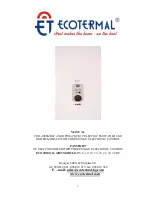
52
maintenance
Maintenance is an essential part of the safe and effi
cient operation
of the boiler and ensures its durability. It should be performed
according to the instructions given in current legislation. Perform
combustion analysis regularly in order to check the operating
effi
ciency of the boiler and to make sure any polluting substances
relased are within the boudaries set by current legislation.
Before beginning maintenance work:
-
Disconnect the appliance from the electricity supply by turning
the external bipolar switch to the “OFF” position;
-
Close the gas valve and the central heating and domestic hot
water system valve.
After the work has been completed the initial settings will be
restored.
Genera
l
comments
It is recommended that the following inspections be carried out on
the boiler at least once a year:
1. Check the seals in the water part and, if necessary, replace the
gaskets and restore the seal to perfect working order.
2. Check the seals in the gas part and, if necessary, replace the
gaskets and restore the seal to perfect working order.
3. Visually check the overall condition of the boiler.
4. Visually check the combustion and, if necessary, disassemble
and clean the burner.
5. Following the inspection detailed in point “3”, disassemble and
clean the combustion chamber, if necessary.
6. Following the inspection detailed in point “4”, disassemble and
clean the burner and injector, if necessary.
7. Cleaning the primary heat exchanger
8. Make sure the following heating safety devices are operating
correctly:
- temperature limit safety device.
9. Make sure that the following gas part safety devices are
operating correctly:
- absence of gas or fl ame safety device (ionisation).
10. Check the effi
ciency of the domestic hot water production
process (test the fl ow rate and temperature).
11. Perform a general inspection of the boiler operation.
12. Remove oxide from the detection electrode using an emery
cloth.
O
perationa
l
test
After having carried out the maintenance operations, fi ll the heating
circuit at a pressure of approximately 1.0 bar and release the air from
the system.
Fill the domestic hot water system at the same time.
- Begin operating the boiler.
- If necessary, release the air from the heating system again.
- Check the settings and make sure all the command, adjustment
and monitoring parts are working correctly.
- Check the seal and that the system for the expulsion of fumes/
suction of comburent air is operating correctly.
Draining
procedures
The heating system must be drained using the following procedure:
- Switch off the boiler, make sure the external bipolar switch is in
the OFF position and shut off the gas valve;
- Loosen the automatic air relief valve;
- Open the system discharge valve and collect the escaping water
in a container;
- Empty the water from the lowest points of the system (where
applicable).
If the system is to be left inactive in areas where the room
temperature may fall below 0°C during winter, we recommend that
anti-freeze liquid is added to the water in the heating system in
order to avoid the need for repeated draining; when this liquid is
used make sure it is compatible with the stainless steel used for the
bodywork of the boiler.
We recommend the use of anti-freeze products which contain
PROPYLENE GLYCOLS as these inhibit corrosion and that they
are used in conjunction with the anti-scaling and anti-corrosion
function, in the quantities suggested by the manufacturer, at the
mimimum temperature.
Regularly check the pH level of the water/anti-freeze mix in the
boiler circuit and replace it when the value measured is lower than
the limit prescribed by the manufacturer.
D
O NOT M
I
X
DIFFE
R
E
NT TYP
E
S O
F
ANT
I
-
F
R
EE
Z
E
.
The manufacturer will not be held liable for any damage caused by
the appliance or the system due to the use of inappropriate anti-
freeze substances or additives.
Draining
the
domestic
hot
w
ater
system
Every time there is a danger of freezing, the domestic hot water
system must be drained as follows:
- Shut off the water mains inlet valve;
- Open all the hot and cold water taps;
- Empty the water from the lowest points of the system (where
applicable).
WARN
I
N
G
Before handling, empty all components which may contain hot
water, performing bleeding where necessary.
Descale the components in accordance with the instructions
provided on the safety data leafl et supplied with the product used,
make sure the room is well ventilated, wear protective clothing,
avoid mixing diff erent products, and protect the appliance and
surrounding objects.
Seal all openings used to take a gas pressure reading or to make any
gas adjustments.
Make sure that the nozzle is compatible with the supplied gas.
If a smell of burning is detected or smoke is seen leaking from the
appliance, or there is a smell of gas, disconnect it from the electricity
supply, shut off the gas valve, open the windows and call for
technical assistance.
Summary of Contents for CLAS B 28 FF
Page 1: ...Installation and Service Instructions CLAS B ...
Page 2: ......
Page 3: ...3 总 则 ...
Page 4: ...4 1 2 3 4 5 6 7 8 15 14 13 12 11 10 9 ...
Page 5: ...ø ø ø ø ø ø ø 312 ...
Page 6: ......
Page 7: ......
Page 8: ......
Page 9: ...安装 水路系统图 ...
Page 10: ...安装 单独 ...
Page 11: ...ø ø ø ø ø 28 ...
Page 12: ... ...
Page 13: ......
Page 14: ......
Page 15: ...15 1 a 3 c 2 b 4 d 试运行 燃气设置的检查 ...
Page 16: ......
Page 18: ...18 ...
Page 19: ......
Page 20: ......
Page 21: ......
Page 22: ......
Page 23: ......
Page 24: ......
Page 25: ......
Page 26: ......
Page 54: ......
Page 55: ......





































